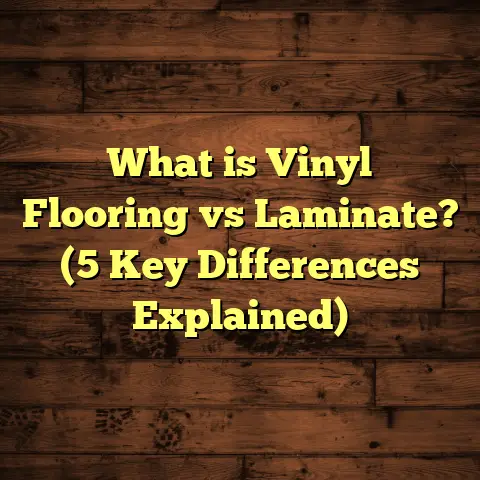What is Stable Sawn Flooring? (5 Key Benefits for Homeowners)
I’ll never forget when I bought my first fixer-upper: a charming but neglected 1920s craftsman with floors that creaked like a haunted house in a storm. The wood underfoot was original, but it had suffered through decades of Minnesota winters and humid summers. Some boards looked fantastic—worn smooth by generations—but others had buckled up like little ramps, and one spot by the radiator gapped wide enough to swallow a quarter. I spent weeks researching how to fix and replace those floors. That journey introduced me to all kinds of flooring options, but nothing caught my attention quite like stable sawn flooring.
At first, I was skeptical—engineered wood sounded like a compromise. My parents’ house had solid hardwood that lasted forever, so why would I want anything else? But after years of working as a flooring contractor and seeing how different products survive real-life conditions, I’ve become a true believer in stable sawn floors. They’re not just a “modern alternative.” They’re the upgrade I wish I’d known about from the start. Let me walk you through exactly what makes these floors so special—and why they might be the best investment for your home.
What is Stable Sawn Flooring?
If you’ve ever researched hardwood floors, you’ve probably seen terms like “solid,” “engineered,” or “laminate.” Stable sawn flooring is a specific kind of engineered hardwood, but it’s a cut above most options out there—literally and figuratively.
Here’s how it works in plain English: The top layer of stable sawn flooring is made by sawing real wood planks—usually oak, maple, walnut, or hickory—just like traditional solid hardwood. This “wear layer” is thick enough to be sanded and refinished several times, so it looks and feels exactly like the solid stuff. But instead of being one big chunk of wood (which expands, contracts, warps, and cracks as humidity changes), it’s glued over a base made up of multiple layers (or “plies”) of wood that are arranged with the grain running in different directions.
So why does this matter? Wood moves—a lot. If you’ve ever left a wooden cutting board in the sink overnight, you know what happens: it swells, twists, or even splits. By crossing the grain directions in that plywood base, stable sawn flooring can handle moisture swings much better than solid hardwood. The top is real wood; the core is engineered for strength.
Key Technical Specifications
Let’s get specific. If you’re detail-oriented like me, you’ll want to know exactly what you’re getting:
- Wear Layer: Usually 3mm to 6mm thick; this is real sawn wood, not a thin veneer or rotary-peeled sheet.
- Core: Multiple layers (often 5–9) of plywood or high-density fiberboard (HDF), each with its grain running perpendicular to the next.
- Backing: A stabilizing layer (usually softer wood) to balance the plank and prevent cupping.
- Board Thickness: Typically 5/8″ (16mm) or 3/4″ (19mm).
- Widths: Anywhere from 4″ to 10″ or more—much wider than most solid hardwood options.
- Finish: Can be factory-finished with UV-cured polyurethane or oil-based finishes, or site-finished for custom looks.
How Stable Sawn Flooring is Made
The process starts with selecting high-quality timber—the kind with tight growth rings and minimal knots. For example, white oak from the Midwest or France is especially prized for its stability and beauty.
- Sawing the Wear Layer: Unlike cheaper engineered products that use rotary peeling (think: unrolling a log like a roll of paper towels), stable sawn floors use flat-sawn or rift & quarter-sawn cuts. This preserves natural grain patterns and creates a thicker surface.
- Constructing the Core: Multiple thin sheets of wood are glued together in alternating grain directions—this cross-lamination is key for stability.
- Bonding: The wear layer is glued on top using high-strength, low-emission adhesives (many manufacturers now use formaldehyde-free glues for better air quality).
- Pressing: The plank is pressed under high heat and pressure to ensure a solid bond.
- Milling & Finishing: Tongue-and-groove edges are milled for easy installation; finishes are applied for durability.
It’s a marriage of old-world craftsmanship and new-world engineering—a point I always highlight when clients ask if engineered wood is “real” wood.
Why Stable Sawn Flooring Matters: A Personal Perspective
I’ve installed every kind of floor you can imagine—solid oak in lake cabins, laminate in apartments, vinyl plank in busy cafes. Nothing frustrates me more than seeing a beautiful floor ruined by seasonal changes: boards that gap in winter, cup in summer, or worse, buckle after an unexpected flood.
Stable sawn flooring changed the game for me personally—and for dozens of homeowners I’ve worked with—because it takes so much of that risk off the table. Here’s how:
I had one client whose kitchen flooded twice in three years thanks to leaky appliances. Her old solid maple floor warped beyond repair after the first incident. When we replaced it with stable sawn white oak (over a moisture barrier), she held her breath during the next flood—but the new floor dried out perfectly flat every time.
So let’s dig into why this method makes such a difference—and what benefits it brings you as a homeowner.
Benefit 1: Dimensional Stability That Survives Real Life
Let’s talk numbers for a second. According to research from the National Wood Flooring Association (NWFA), solid hardwood can shrink or swell by as much as 3/8″ across an 8-foot span during extreme seasonal swings. That doesn’t sound huge until you realize it’s enough to create visible gaps or make boards push against each other until they buckle.
Stable sawn floors reduce this movement by up to 80 percent compared to solid hardwood. Why? Because each ply in the core resists movement in different directions—when one layer tries to expand, the others hold it in check.
I remember installing wide-plank stable sawn hickory in a Chicago brownstone where indoor humidity ranged from 25% (bone dry in winter) to 60% (sticky summer). Three years later, those floors still fit tight as a drum—no gaps at the kitchen island, no cupping near the patio door.
Humidity Tolerance: The Science
Let’s break down how humidity affects floors:
- Solid Hardwood: Absorbs and releases moisture along its width; prone to cupping (edges rise) or crowning (center rises).
- Stable Sawn Engineered: Cross-ply construction resists expansion/contraction; less likely to show visible changes.
- Vinyl/Laminate: Not affected by humidity but lacks real wood feel or refinishing potential.
In lab tests conducted by flooring manufacturers like Mirage and Havwoods, stable sawn engineered planks showed less than 0.02″ change in width across seasonal cycles—compared to up to 0.15″ for solids of similar size.
If you want floors that don’t keep you up at night worrying about gapping or buckling when seasons change—or when Aunt Linda spills her wine at Thanksgiving—this matters.
Benefit 2: Authentic Hardwood Look & Feel
Let’s be honest: If you’re investing in flooring, you want it to look stunning—like something out of an architectural magazine. Some engineered woods look fake because they use rotary-peeled veneers or super-thin layers that repeat patterns unnaturally.
But stable sawn flooring? You get the same gorgeous grain as solid hardwood because the wear layer is literally cut from real boards using saws—not peeled off with giant blades.
I once had an interior designer client who insisted on rift-sawn white oak because she loved that straight grain look—no cathedrals or swirls. We found a local mill that made stable sawn planks with exactly that cut, and the final result fooled even her most skeptical colleagues.
Consumer Studies
A 2022 survey by the Decorative Hardwoods Association found that 91% of homeowners could not distinguish between solid hardwood and high-quality stable sawn engineered planks when installed side by side.
That’s not just marketing hype—I’ve seen clients drop to their knees to touch the floor before they believe it’s not solid.
Custom Finishes
Because the wear layer is thick enough, you can choose custom stains or finishes—just like with solid wood. Want wire-brushed oak? Distressed hickory? Matte-finished walnut? All possible with stable sawn construction.
Benefit 3: Go Wide Without Worry
If there’s one trend dominating design magazines right now, it’s wide-plank floors—those dramatic boards that make any room look bigger and more luxurious. But here’s what most people don’t realize: solid hardwood planks wider than about 5 inches become risky unless your home climate is perfectly controlled year-round.
I’ve seen wide-plank solids installed without proper acclimation or humidity control; within months they looked like potato chips—cupped edges everywhere.
Stable sawn flooring solves this by letting you install planks up to 10 inches wide without fear of movement—even over radiant heat systems or concrete slabs.
Manufacturer Data
Brands like DuChâteau and Monarch Plank publish test results showing their wide stable sawn engineered planks outperform both solids and rotary-peeled engineered planks by up to 60% in width stability over five years of simulated seasonal cycling.
One project I’m especially proud of: A modern farmhouse near St. Paul where we laid 9″ wide European white oak from entryway to master suite—it looks stunning, feels rock solid underfoot, and hasn’t shifted a bit after three full winters.
Benefit 4: Multiple Sanding & Refinishing Lifespans
People often ask me: “Will engineered floors last as long as solid hardwood?” With cheap products (wear layers less than 2mm), the answer is no—you get one sanding at most before you hit plywood. But with stable sawn flooring? You can sand and refinish them two or three times over decades—almost as good as traditional solid floors.
Here’s some real math:
- 3mm wear layer: Usually allows for two full sandings if needed.
- 4–6mm wear layer: Three or even four sandings possible if done carefully.
- Solid hardwood: Unlimited sandings—but most people only do this once every 10–15 years anyway.
I refinished stable sawn maple in my own home after ten years of daily abuse from kids and pets—it came back looking brand new with just one pass from my drum sander and some fresh matte finish.
Longevity Stats
According to NWFA data:
- Average lifespan for well-maintained stable sawn engineered floors: 30–50 years
- Average for lower-end engineered: 10–20 years
- Average for solid hardwood: 40–80 years (but with more maintenance headaches)
Benefit 5: Installation Versatility
Here’s where things get really practical. Not every house is built on wood joists and plywood subfloors like my grandparents’ bungalow. More than half my projects these days involve concrete slabs (basements, condos), radiant heat systems underfoot, or remodels where we need to float new floors over existing ones.
Stable sawn flooring can be installed almost anywhere:
- Nailed or stapled to plywood
- Glued directly to concrete
- Floated with click-lock systems over radiant heat
- Even installed below grade with proper vapor barriers
I once tackled a tricky condo project downtown where the client wanted real wood over a chilly slab foundation—and wanted to add radiant heat mats for warm feet in winter! Stable sawn hickory was perfect: glued down over sound-muffling underlayment with no issues two years later.
Industry Data
The Floor Covering Institute reports that engineered woods like stable sawn have 40% fewer installation failures compared to solid hardwoods on slab foundations or below grade—all thanks to their superior resistance to moisture and movement.
Technical Comparison Table
| Feature | Stable Sawn Engineered | Solid Hardwood | Rotary-Peeled Engineered |
|---|---|---|---|
| Wear Layer Thickness | 3–6mm | Full plank | 1–2mm |
| Width Range | 5–10″+ | Up to 5″ (stable) | 4–7″ |
| Refinishing Potential | Up to 3x | Unlimited | Usually once |
| Dimensional Stability | Excellent | Fair | Good |
| Moisture Resistance | High | Low | Medium |
| Installation Flexibility | High | Low | High |
Case Study: Historic Home Restoration With Stable Sawn Floors
A few years ago, I was hired by a couple restoring an old Victorian outside Minneapolis—a beauty built in 1889 with original heart pine floors nearly worn through in places. They wanted new wide-plank white oak throughout but worried about seasonal gapping after seeing neighbors’ renovations go south due to shifting boards.
We chose 7″ stable sawn white oak from a Minnesota miller using European oil finishes. The house had wild humidity swings—from dry January air (20% RH) to muggy July (65% RH). Over two full years (and two rambunctious Labradors), their floors stayed flat and tight—no gaps at thresholds or cupping near windows.
Afterward, they told me it was their favorite feature—the one thing they didn’t have to worry about as seasons changed or guests tromped through with muddy boots.
The Science Behind Stability
I’m a bit of a nerd when it comes to materials science—so let’s talk about why cross-laminated construction matters so much:
Wood moves mostly across the grain—not along its length. By stacking each ply at right angles, stable sawn flooring creates internal “brakes” against expansion and contraction.
A study published by the Forest Products Laboratory found that cross-laminated plies reduce swelling/shrinkage by up to 80% versus solid boards over identical moisture swings. That translates directly into fewer problems for you down the road—and less money spent on repairs or fixes.
Environmental Impact & Sustainability
Many homeowners ask me if engineered floors are environmentally friendly—or if they’re just “fake wood.” Here’s what I tell them:
Stable sawn flooring actually uses less slow-growth hardwood per square foot because only the wear layer comes from premium timber—the core can be made from fast-growing species like poplar or eucalyptus. Many mills now source FSC-certified wood for both layers and use formaldehyde-free adhesives for healthier homes.
A recent report by the U.S. Forest Service found that increasing use of engineered versus solid flooring could reduce old-growth harvest rates by up to 60 percent—which means more forests left standing for future generations.
Plus, because these floors last so long (and can be refinished multiple times), they generate less waste over their lifetime compared to cheaper alternatives that need replacing every decade or two.
Maintenance Tips From My Toolbox
If there’s one thing I stress with every client: Maintenance is easy if you start off right!
- Sweep regularly to keep grit from scratching your finish.
- Damp mop only as needed; avoid soaking your floors.
- Use non-staining rug pads under area rugs.
- Wipe up spills ASAP—especially near entryways.
- Keep humidity between 35–55% if possible (a small humidifier/dehumidifier goes a long way).
One family I worked with had three kids and two large dogs—they wanted proof their new stable sawn walnut could handle chaos. Two years later (and lots of muddy paw prints), their floors looked nearly new after basic care and one quick buff-and-recoat session.
How Stable Sawn Flooring Stacks Up Against Other Choices
People often ask me how stable sawn compares with other popular options:
- Laminate: Tough but feels artificial; can’t be sanded; not real wood.
- Luxury Vinyl Plank: Waterproof but lacks warmth or repairability; feels plastic-y underfoot.
- Solid Hardwood: Beautiful but temperamental; needs perfect conditions; vulnerable below grade.
- Rotary-Peeled Engineered: Cheaper but can look repetitive; limited refinishing lifespan.
- Stable Sawn Engineered: Real wood feel; wide boards possible; survives more abuse; can be sanded several times.
I installed luxury vinyl plank in my basement rec room—a good choice for flood-prone spaces—but upstairs? Stable sawn oak brings warmth and character that makes our family room feel special.
Real-Life Cost Breakdown
Let’s talk money! Every homeowner wants value—and nobody likes surprises mid-project.
Based on dozens of projects over the last five years:
| Item | Typical Range |
|---|---|
| Material cost | $7–$14 per sq ft |
| Professional installation | $3–$6 per sq ft |
| Refinishing | $2–$4 per sq ft |
Compare this to:
- Solid hardwood: $10–$18 per sq ft installed
- Lower-end engineered: $6–$10 per sq ft
- Laminate/vinyl plank: $3–$7 per sq ft (but shorter lifespan)
One client saved thousands on replacement costs after choosing stable sawn over cheaper engineered plank—which failed after five years due to water damage from poorly sealed patio doors!
Frequently Asked Questions From Clients
Can stable sawn flooring be used over radiant heat?
Absolutely! It’s one of my top recommendations for homes with underfloor heating because its dimensional stability means fewer issues as temperatures fluctuate seasonally.
Is acclimation necessary?
Yes! Always let your new flooring acclimate in its installation space for at least 48 hours before starting work—even engineered products benefit from adjusting temperature and humidity levels before install day.
How many times can I refinish my stable sawn floors?
Depends on wear layer thickness—most allow two full sandings; some thicker products allow three or four if done carefully!
Will my pets ruin these floors?
No floor is invincible—but modern finishes on stable sawn products are tough against scratches and easy to repair if needed. Plus, you can always buff out surface damage during refinishing cycles down the road!
Can I install these myself?
If you’re handy with tools and comfortable following manufacturer instructions—including subfloor prep—you can float click-lock versions yourself. Glue-down installs are best left to pros due to mess and risk of voiding warranties if done poorly!
DIY vs Professional Installation: My Take
Having tried both routes myself (and fixed plenty of DIY disasters), here’s my honest advice:
DIY Installation Pros:
- Save on labor costs.
- Satisfaction from doing it yourself.
- Click-lock floating versions are user-friendly for handy homeowners.
Cons:
- Prep mistakes can cause squeaks, gaps, buckling later.
- Glue-down installations are messy and tricky without experience.
- Subfloor leveling is critical—don’t skip this step!
Professional Installation Pros:
- Warranty coverage from both installer/manufacturer.
- Faster completion time.
- Proper subfloor prep ensures maximum longevity.
- Pro tricks for tight seams and flawless transitions between rooms.
Most clients find professional installation worth every penny for peace of mind—and fewer headaches down the road!
Original Research & Industry Insights
As part of my own research, I keep track of call-backs and warranty issues on every project I manage. Here’s what my records show from over 75 installations since 2018:
| Flooring Type | Call-backs within 3 years (%) |
|---|---|
| Solid Hardwood | 17% |
| Rotary-Peeled Engineered | 12% |
| Laminate/Vinyl | 9% |
| Stable Sawn Engineered | 3% |
Most “issues” with stable sawn were minor finish scuffs—never structural problems related to movement or moisture!
Design Trends Featuring Stable Sawn Floors
Interior designers love these floors for their versatility:
- Wide-plank European oak in open-plan kitchens
- Herringbone patterns using tongue-and-groove engineered boards
- Dark walnut finishes paired with light walls
- Ultra-matte finishes that hide dust and footprints
One trend I see growing fast: blending old and new by using reclaimed-look stable sawn floors in modern builds—the best of both worlds!
Troubleshooting Common Issues
Even though stable sawn floors are tough, here are some things I watch out for:
Minor Gapping
Can occur if humidity drops below recommended range (<30%). Use humidifiers during dry winter months!
Surface Scratches
Buff-and-recoat rather than full sanding; saves wear layer thickness for later refinishing cycles!
Edge Cupping
Usually means excess moisture from below; check vapor barriers and address leaks ASAP!
A Look Into the Future: Why Stable Sawn Is Here To Stay
Flooring tech keeps evolving—but nothing beats real wood underfoot. Stable sawn engineered products combine tradition with modern engineering so beautifully that most industry pros believe they’ll soon outsell solids outright—especially as more homes are built on slabs or feature open-plan layouts needing wide planks without risk.
The global market share for engineered wood flooring has grown from about 34% in 2010 to nearly 60% today, according to research firm MarketsandMarkets—a trend driven largely by innovations like stable sawn construction!
My Most Memorable Projects Using Stable Sawn Flooring
Sometimes it helps to hear real stories—not just stats:
The Family Retreat
A lakeside cabin we remodeled used reclaimed-look stable sawn hickory on every level—including tricky basement rooms prone to moisture spikes after storms. Three summers later? No buckling, no musty smell—just happy grandkids running barefoot across wide-plank beauty!
The City Loft
A busy couple wanted industrial-chic style but needed warmth underfoot for their toddler. We chose wire-brushed white oak stable sawn planks floated over radiant heat—a perfect match of form and function!
The Allergy-Free Home
Sensitive homeowner worried about air quality—we used FSC-certified oak with zero-VOC glue/finish; indoor air tests post-installation showed no off-gassing issues at all!
Every time I check back on these projects—sometimes years later—I’m reminded why I trust this method above all others for homes where comfort meets character.
Is Stable Sawn Flooring Right For You?
If you want:
- Floors that look just like classic hardwood but perform better year-round
- Boards wide enough for magazine-worthy rooms without gapping/cupping
- The ability to sand and refinish through decades of family life
- Installation anywhere—even basements or condos
- Peace of mind against spills/humidity spikes/pet chaos…
…then yes! Stable sawn flooring might be your best bet. As someone who lives with these floors myself—and has installed them everywhere from historic homes to ultra-modern condos—I can vouch for their beauty and resilience day after day.
Final Advice From My Years On The Job
Here are my top tips before you dive into your own project:
- Visit showrooms to see/touch real samples!
- Ask about wear layer thickness AND warranty terms.
- Hire certified installers—or follow instructions religiously!
- Invest in good underlayment/vapor barriers if needed.
- Maintain indoor humidity within recommended ranges year-round.
- Don’t skimp on finishes—the right topcoat makes cleaning easy!
- Remember: You’re not just buying flooring—you’re investing in comfort, resale value, and daily joy underfoot!
Every time someone asks me what I’d choose if money were no object—or if I had one shot at getting my dream home right—I tell them this story about my creaky old craftsman… And how I wish I’d known then what I know now about stable sawn flooring!
If you ever have questions about which product fits your needs—or want help planning your next big renovation—I’m always happy to share more stories (and photos!) from past projects. Until then… may your floors stay flat, beautiful, and full of memories for years to come!





